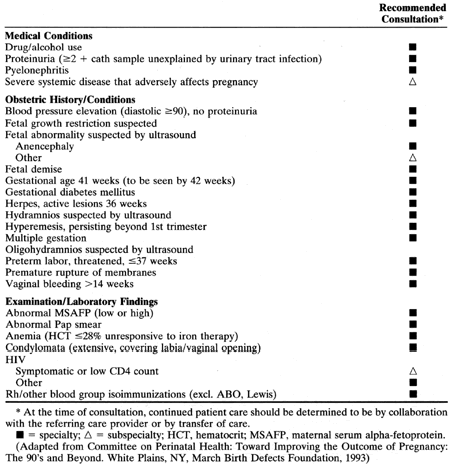Prenatal Care Documentation and Triage
Authors
INTRODUCTION
Consistent with the goals of regional coordination, improved pregnancy outcomes have been associated with risk identification, care in a setting appropriate for the level of risk, and transfer to an appropriate facility when necessary. Specifically, premature and low-birth-weight infants born in subspecialty care hospitals have better survival rates, even after controlling for interhospital differences in birth-weight distribution, race, gestational age, and multiple births. The greatest impact has been in reducing the mortality of neonates weighing less than 1500 g at birth.
Although the reported incidence of low birth weight and very low birth weight in the United States is higher than in at least a dozen other industrialized nations, the birth-weight-specific survival rates among infants in this country are among the best in the world. This phenomenon has been attributed to the technologically advanced care provided to newborns through regionalized inpatient services.
A regionally coordinated system focusing on levels of hospital-based perinatal care has been shown to be effective, resulting in improved outcomes for mothers and newborns. Such a system can be extended to encompass preconception evaluation and early pregnancy risk assessment in both an ambulatory and hospital-based setting. The recommendations by the Committee on Perinatal Health1 emphasize early recognition and triage of potential prenatal problems before pregnancy or in the early prenatal period. Based on the level of care provided, functional capabilities of providers are defined, and those capabilities are related to inpatient maternal and neonatal needs.
The overall goals for regional coordination of ambulatory prenatal care are (1) to ensure appropriate care for all women, (2) to make better use of available resources, and (3) to improve the outcome of pregnancy. By defining provider capabilities and expertise, and by ensuring that pregnant women receive risk-appropriate care, this system enables prenatal care to be delivered more effectively and efficiently. Developments in maternal-fetal risk assessment and diagnosis, as well as interventions to change maternal behavior, make early and continuous prenatal care more effective in improving pregnancy outcome.
Risk-responsive prenatal care may call upon the services of many kinds of providers within a perinatal region. The responsibilities and the degree of intensity of prenatal care should be proportional to the degree of risk and the potential for intervention. All providers of prenatal care should be able to identify a full range of medical and psychosocial risks and to refer patients for appropriate care throughout pregnancy. They should place greater emphasis on early prenatal risk assessment, with appropriate referral and consultation among providers of basic, specialty, and subspecialty levels of prenatal care. Early and ongoing risk assessment should become a universal component of maternity care. Depending on individual patient circumstances and the expertise of the individual provider, additional consultation may or may not be needed (Table 1A and Table 1B).
TABLE 1A. Early Pregnancy Identification for Consultation

TABLE 1B. Ongoing Pregnancy Risk Identification for Consultation

Comprehensive risk assessment enables the prenatal care provider to determine whether the woman, the fetus, or the infant is at increased risk. Risk factors are characteristics that indicate the possibility of adverse outcome and help guide actions by the woman, her social support network, and her advisors. Because of the dynamic nature of pregnancy, risk assessment must be an ongoing activity throughout prenatal care and at the time of birth. Risk identification should entail the development of a specific plan of care, as well as arrangements for referral and consultation. The content and timing of prenatal care should vary depending on the risk status of the mother and fetus. The use of a standardized (i.e., common) prenatal record (see Appendix1 among public and private providers within a perinatal region will greatly facilitate communication, thereby enabling continuity of care and enhancing risk assessment and intervention activities.
The primary goals of early and ongoing risk assessment are to prevent or treat conditions associated with morbidity and mortality and to improve linkages to inpatient care through more effective referral and consultation mechanisms. Overall, standardization of data collection and recording, as well as early systematic risk assessment, will accomplish the following:
- Better match of care to patient needs
- More efficient use of resources
- Expeditious and appropriate transfers and referrals
- Reduced numbers of emergency transfers and referrals
REFERENCES
Committee on Perinatal Health: Toward Improving the Outcome of Pregnancy—The 90s and Beyond. White Plains, NY, March of Dimes Birth Defects Foundation, 1993 |

